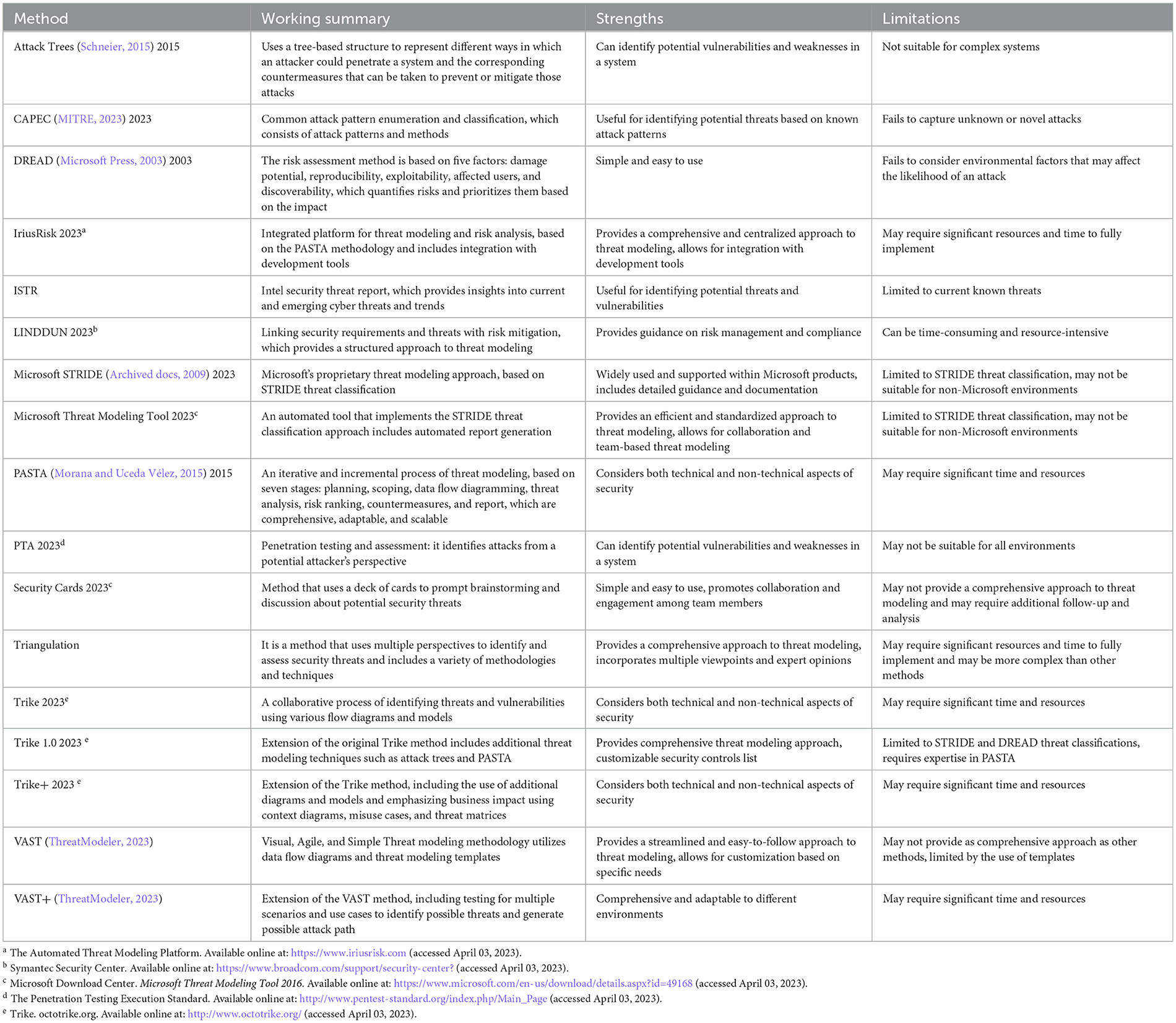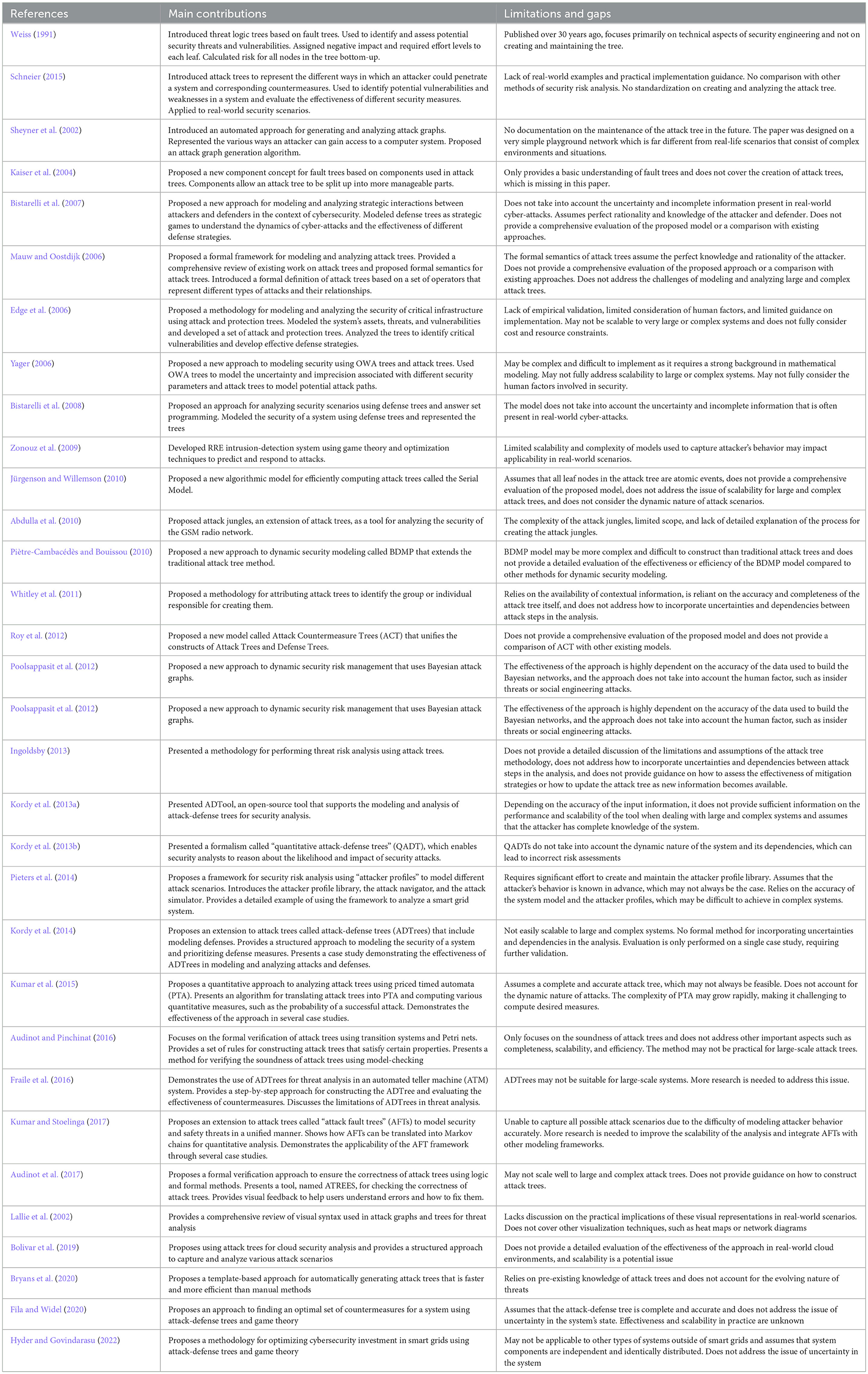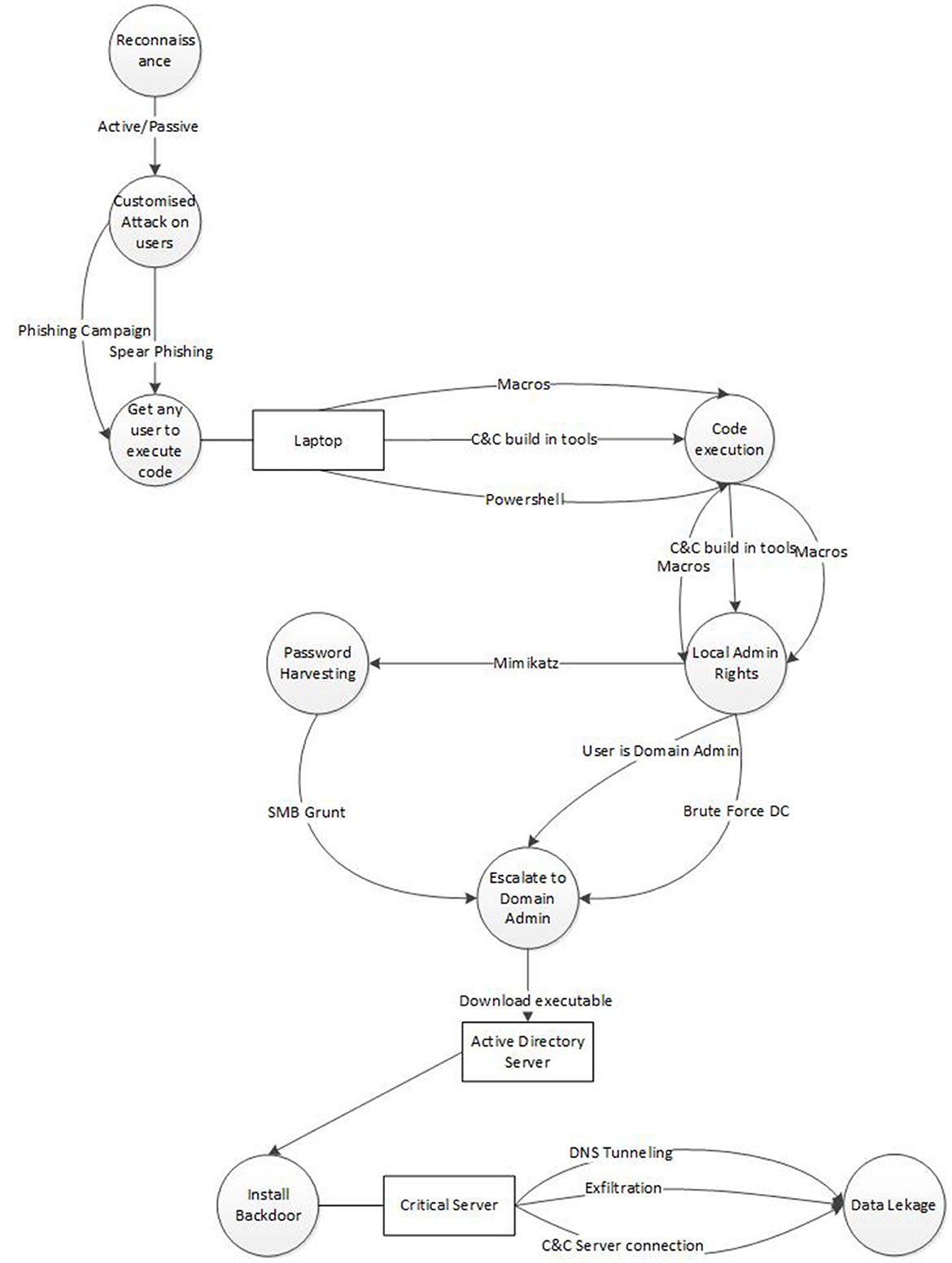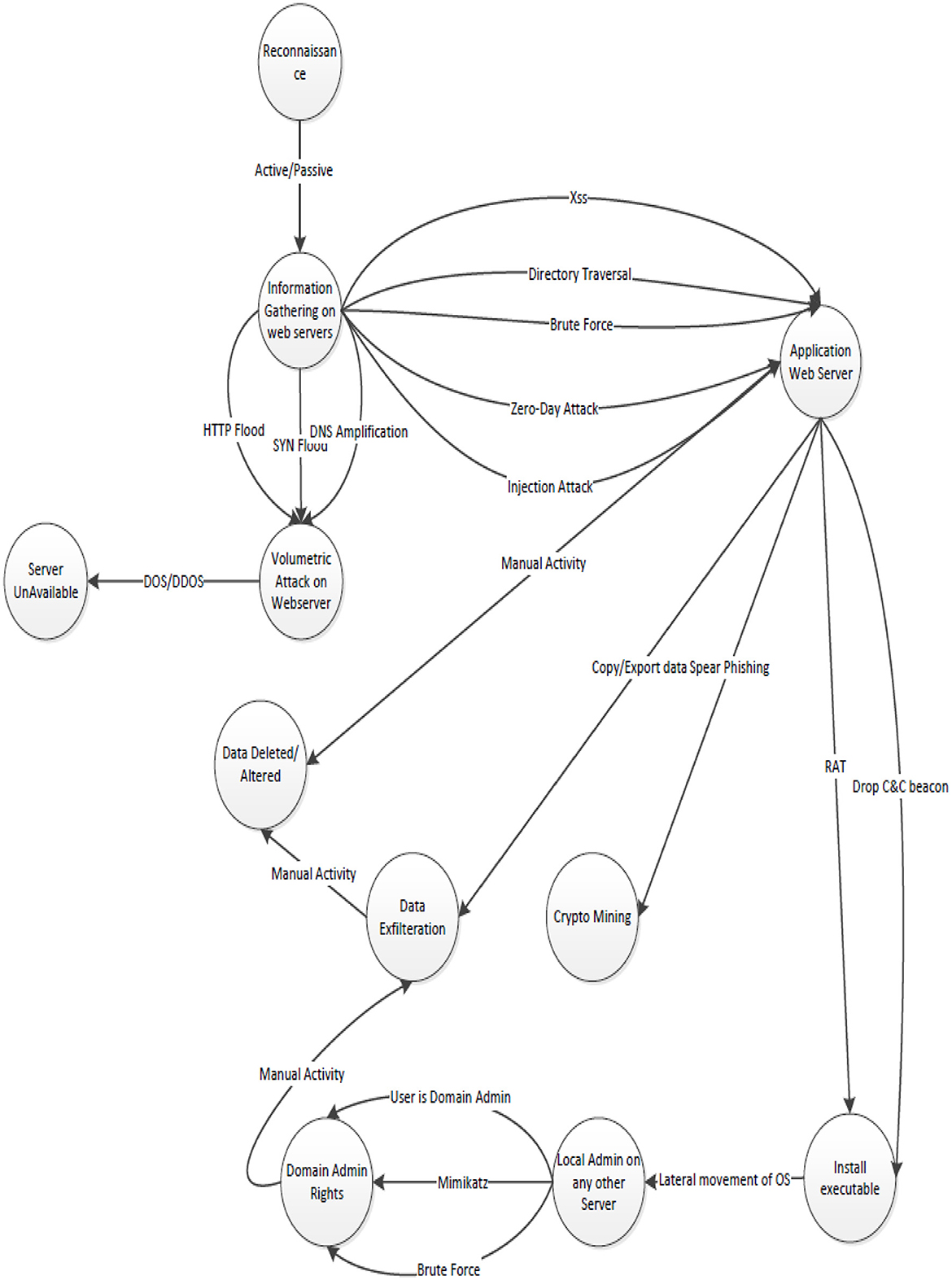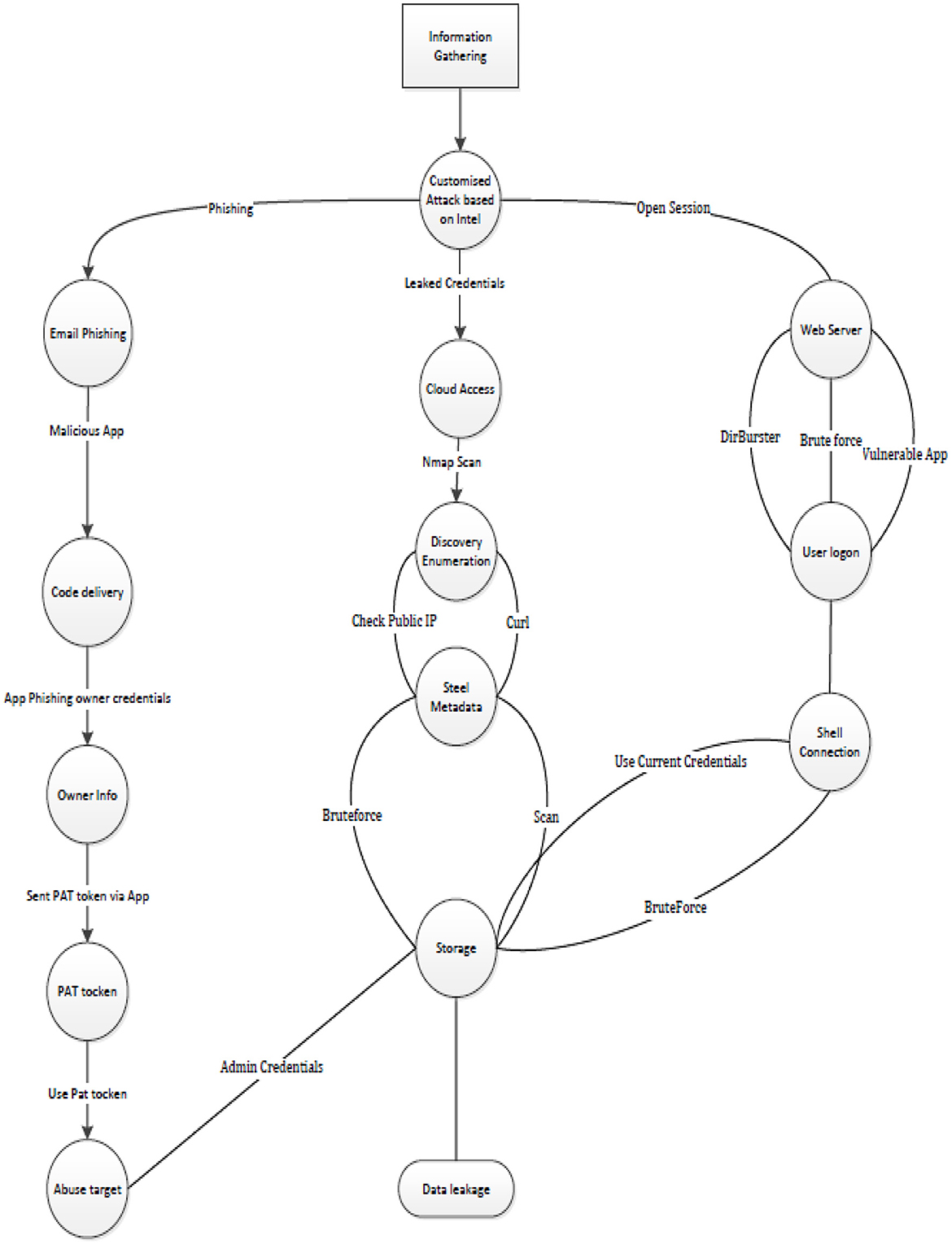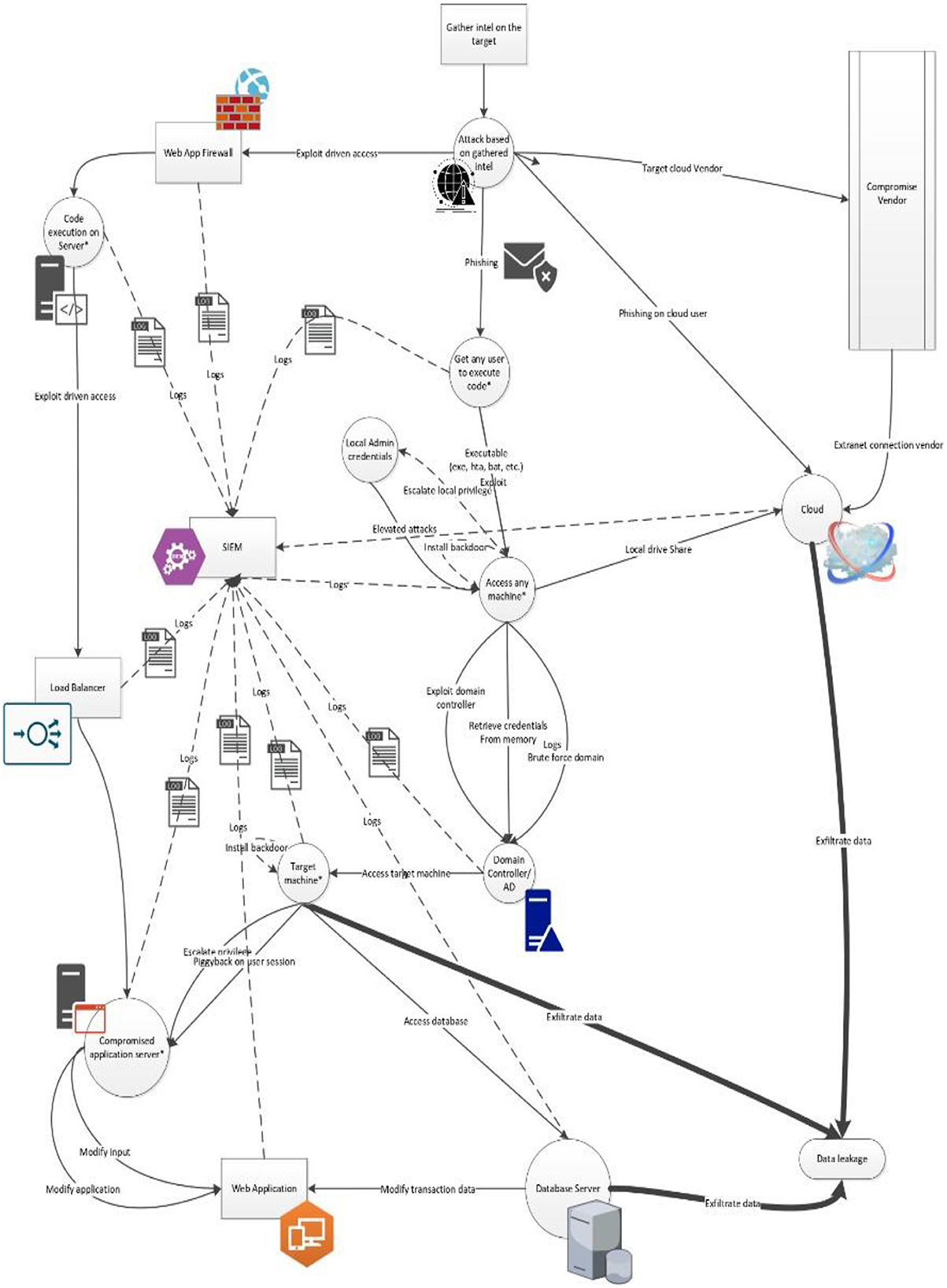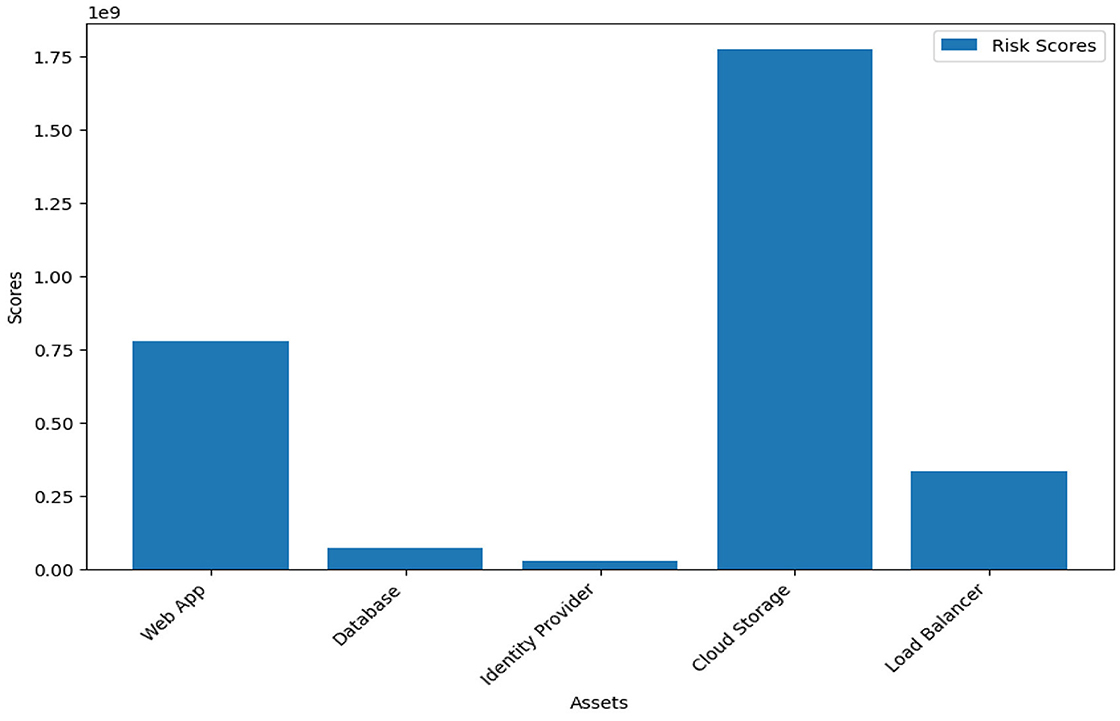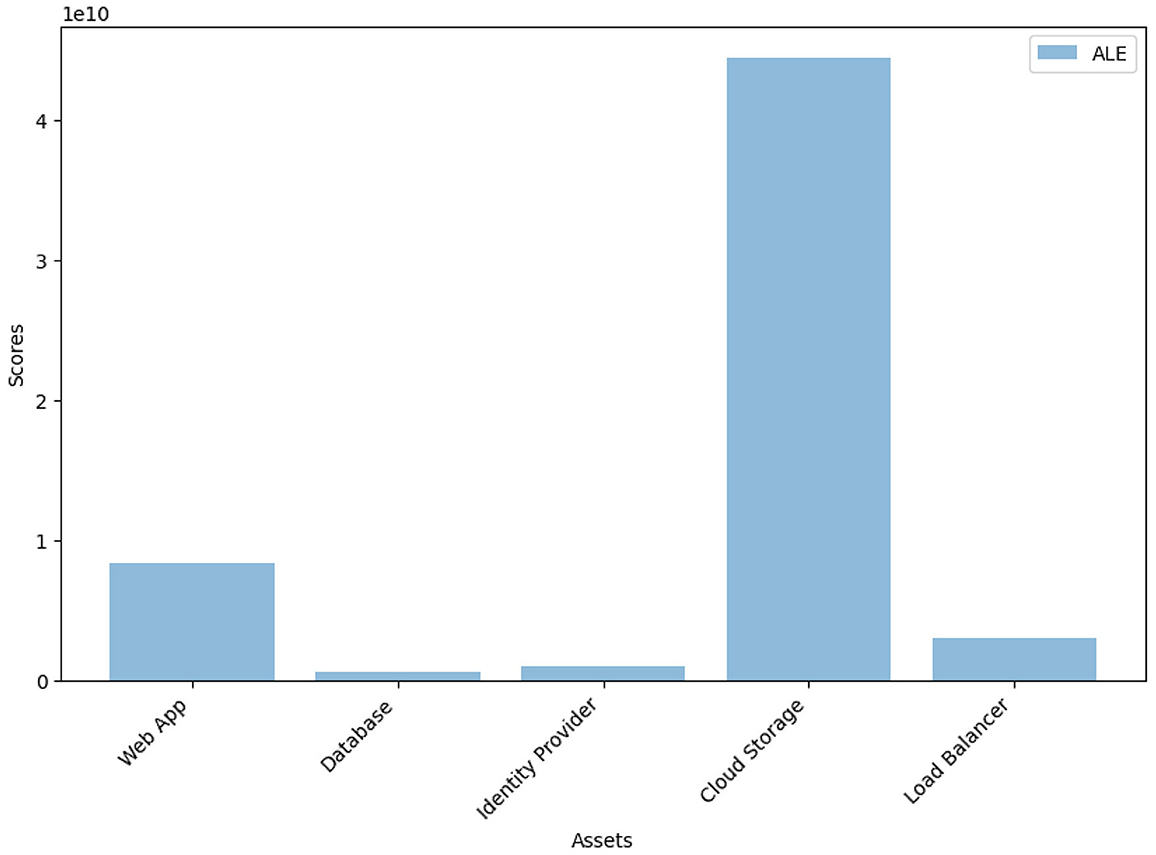- 1MVN University, Faridabad, India
- 2Maharaja Agrasen Institute of Technology, Delhi, India
Attack trees are a widely used method for threat modeling and analyzing cyber-attacks in organizational networks. Assessing the risk associated with each individual node of an attack tree is crucial for understanding the overall risk of the attack. This article presents a comparative study of different threat modeling methods and risk assessment approaches in organizational networks. The article also presents a novel comprehensive approach for quantifying risk assessment of organizational networks based on attack trees modified according to the factor analysis of information risk (FAIR) approach. Our results demonstrate the effectiveness of the novel approach in capturing the unique characteristics of different assets and their dependencies in an attack tree, leading to quantitative risk assessment.
1 Introduction
The increasing reliance on information technology in our daily lives has led to a corresponding rise in the number and severity of cyber-attacks. There are a variety of threat modeling tools available for the analysis and management of organizational asset security, where each method has its own strengths and limitations. Attack trees are a commonly used graphical technique for modeling and analyzing cyber-attacks, allowing analysts to understand the different stages of an attack and identify vulnerabilities that can be exploited. Attack trees are primarily scenario-based and portray the potential steps an attacker could take to compromise a system or network. An attack tree is essentially a tree structure where each node represents a possible attack method or subgoal, and the edges represent the relationship between them. The paths in trees are used to represent the mindset of an attacker, to penetrate the network to gain access to sensitive information or disrupt services. Attack trees also provide a useful communication tool for security professionals to discuss and convey the risks associated with a particular system or network. By presenting the attack tree in a visual format, it is easier for stakeholders to understand the potential threats and make informed decisions about risk management strategies.
Assessing the risk associated with each node of an attack tree is a critical step in understanding the overall risk of the attack. This allows the organization to prioritize its security efforts and focus on the most critical areas of the system. Over the years, attack trees have been used by both blue teams and red teams for threat assessment and management.
This study presents a comprehensive review of various threat modeling approaches, including attack trees, along with the evolution of attack trees through the past few decades to understand the gaps in a scenario-based risk assessment presented by attack trees. Based on the gaps identified, the study presents a comprehensive approach for quantifying the risk assessment of organizational networks based on asset properties, including impact, the likelihood of an attack, and the depth of resources. This is a significant improvement over the non-quantified scenario-based approach of the traditional attack trees.
Red teams can leverage attack trees to simulate potential attack paths and identify vulnerabilities in an organization, which can then be exploited to test and improve the organization's defenses.
1. Map potential attack path to simulate: the goal of any red team is to simulate the attacks to exploit vulnerabilities in the target system. Working with attack trees helps with visualizing the various paths. This also helps the stakeholders to understand the risks and potential threats.
2. Identifying weaknesses and attack surface: one of the big advantages of using the red team lies in mapping out potential entry points to exploit and then using them for privilege escalation and lateral movement.
3. Simulate exploit: using the most vulnerable path identified, it can be used to simulate exploits and attacks on the target systems. It can be used by external attack surface management (EASM) to create related IPs and URLs.
4. Improve and retest: the attack trees can be reused during the periodic red teaming exercise to show the hardening and improving the defenses of the organization.
Blue teams, also known as defenders, use the attack trees to improve the security of their organization by identifying potential attack scenarios and developing proactive measures to prevent or mitigate them. Typically, blue teams can use attack trees for the following purposes:
1. Identify attack paths: by using attack trees, blue teams can visualize the potential attack paths that an attacker might take to reach their ultimate goal. This can help the blue team focus their efforts on hardening those points of entry and minimizing the risk of a successful attack.
2. Conduct risk assessments: attack trees can be used to identify and assess the risks associated with specific attack scenarios. Blue teams can use this information to prioritize their security efforts and allocate resources accordingly.
3. Develop defense strategies: attack trees can help blue teams develop proactive defense strategies by identifying potential vulnerabilities, attack vectors, and threat actors. This can include implementing security controls, such as access controls, intrusion detection systems, or network segmentation.
4. Plan incident response: in the event of a security breach, blue teams can use attack trees to quickly identify the attack path and develop an incident response plan. This can help to minimize the impact of the breach and prevent further damage to the organization.
The remainder of the article is organized as follows: Section 2 covers a comprehensive review of the popular threat modeling methods presented with their strengths and limitations. It also covers a comprehensive summary of the threat modeling research focused on attack tree-based methods to explore gaps in the studies. Section 3 includes a detailed research methodology for quantifying risks in the present research, followed by a discussion of the results in Section 4. The article is concluded in Section 5 with some brief directions for future research work in this domain.
2 Literature review
Threat modeling is a systematic approach for identifying and assessing potential security threats and vulnerabilities that could affect an organization or system. It involves analyzing the system's design, identifying potential security weaknesses, and evaluating the likelihood and impact of each threat.
The process of threat modeling has been gaining importance since the 1990s, as the increasing use of computers and the internet led to a rise in cyber-attacks and other security breaches. Threat modeling provides a way to proactively identify and mitigate potential security risks before they can be exploited by attackers. By taking a structured and methodical approach to security, organizations can reduce the likelihood of security breaches and minimize the impact of any that do occur.
Threat modeling has also become more important in recent years as organizations have become increasingly dependent on technology and data to operate their businesses. With the rise of cloud computing, the Internet of Things (IoT), and other new technologies, the attack surface for potential threats has increased, making it more important than ever for organizations to understand and manage their security risks. Threat modeling is a key tool for achieving this goal. Table 1 summarizes the most popular threat modeling tools that have remained in use over the last two decades.
The survey shows that there is a serious lack of automated tools except for IriusRisk, Microsoft Threat Modeling Tool, and VAST+. The majority of the available threat modeling tools are open source, with their roots tracing to attack trees. The present research is focused on attack trees in particular, as a majority of the other threat modeling techniques use some form of patterns originating from the attack tree methodology. There has been a lot of research specific to attack trees, and a summary of the comprehensive literature to review the security research focused on attack trees is presented in Table 2.
The history of the attack tree started with two important articles in which it was formalized by Weiss and Schneier. These research articles ensured that the concept of the attack tree required formalization. This was the first introduction of the AND/OR node, which was later converted to the root node and leaf node. As mentioned in the table above, there are different definitions and explanations of attack trees as graphical tools for modeling and analyzing threats and their importance in threat modeling for an organization. The article on attack trees also introduced the idea that security engineering processes need additional resources allocated to high-risk vulnerabilities to keep the organization secure. There have been multiple explanations regarding the methodologies used in the creation of attack trees, including formalisms, notations, and modeling techniques, i.e., AND/OR trees, STPA, AFT, and ADT. The attack tree has undergone significant transformation in its methodologies and construction and maintenance techniques depending on the complexity of the environment. Various techniques have emerged as fundamental frameworks for constructing attack trees, each offering unique advantages and challenges. Several approaches describe how to design an attack tree. A group of experts proposed designing a tree manually, analytically, and iteratively, considering all possible attack scenarios. There has been an evolution of automated and assisted attack tree generation techniques, which have emerged recently and help to create static scenarios. Despite these evolutions, challenges still exist, which require efforts to address scalability issues, dynamic threats, and integrating attack trees with other modeling methodologies, which is still lacking in the literature review. This has also been addressed below.
2.1 Gaps in the previous research
The most obvious patterns that are implied based on the various research and methods mentioned in Table 2 are as follows:
• Lack of practical translation to real-world scenarios till now; in this study, we are attempting to align attack trees with existing organization networks, which can enhance their practicality by connecting them to established network design and create better visibility within the environment.
• Priority classifications of assets based on priority using attack trees help assess the criticality and importance of various assets within an organization's infrastructure within the organization. Attack trees mentioned in this study describe that help by prioritizing assets, identifying potential threats, and their impacts on those assets.
• Scalability is an issue that has been mentioned in previous research articles and methods when dealing with attack trees, particularly in larger and more complex systems; in this study, we attempted to solve these methods by prioritizing the assets based on their values in the organization, using the modular approach by breaking down the complex attack tree in smaller and more manageable modules.
• The absence of a quantifiable framework for attack tree-based risk assessment using relevant metrics presents a challenge in cybersecurity within the current organization setup. Organizations lack quantitative risk assessment. In this study, we are introducing the factor analysis of information risk (FAIR) approach that balances between complexity and practicality and aims to provide actionable insights to support decision-making processes based on the crown jewels within the organization and their risk related to cybersecurity risk mitigation.
• Visualization techniques, such as color coding or network diagrams, can significantly aid in conveying complex information present in attack trees, and we have used these methods of visualization here in this attack tree.
• The methods focus on either attack defense trees (ADT) or attack fault trees (AFT); no method has been mentioned, and research does a combination where we can help the organization improve its defense using the method.
In recent studies, a test lab setup for simulation and attack tree generation is demonstrated in Gupta et al. (2023), which can be used in conjunction with the MITRE ATT&CK framework with a provision to create and assess various attack scenarios while providing flexibility in subnet configuration and movement, addition or removal of networking devices. In Rana et al. (2023a), the authors have proposed that the attack trees risk assessment is no longer limited to blue team activity, and a dual attack tree-assisted command and control server activity has been proposed to ensure enhanced path coverage and test coverage by the red team during security validation and penetration testing.
3 Bridging the gap with FAIR-modified attack trees
We propose a novel approach for assessing risk quantitatively in modified attack trees based on the FAIR (Freund and Jones, 2015) approach in security. The FAIR approach is a risk management framework that is used to evaluate and analyze the value of data, the potential impact of a security incident, and the cost of implementing security measures.
The FAIR approach involves four steps as follows:
1. Identify assets: the first step is to identify the assets that need to be protected, including data, systems, and processes. This is a standard part of an attack tree assessment as well.
2. Evaluate threats: the second step is to evaluate the threats that could impact those assets. This includes assessing the likelihood and impact of different types of security incidents, such as data breaches, cyber-attacks, or natural disasters. We have modified the threat evaluation to suit the attack tree methodology.
3. Assess vulnerabilities: the third step is to assess the vulnerabilities of the assets and determine how easy they are to exploit. This includes evaluating technical vulnerabilities and human factors that could contribute to security incidents. This is again a standard part of the attack tree methodology, but we have introduced quantified values for vulnerabilities.
4. Determine the risk: the final step is to determine the level of risk associated with each asset. This involves calculating the likelihood and impact of security incidents and the cost of implementing security measures to mitigate those risks. We have added another step to calculate the overall risk score of the organization based on risks calculated for individual assets in the modified attack tree.
To apply the FAIR approach in the context of the attack trees, we have identified and included the following terminology from both domains.
3.1 Countermeasures
The availability of possible countermeasures (such as firewalls, intrusion detection systems, encryption, network segmentation, and access control) for safeguarding critical resources from potential attackers. We have used a range of 0 to 1 to demonstrate the relative values of countermeasure effectiveness (Figure 1).
3.2 Depth
This parameter indicates the number of countermeasures leading to a resource within the organizational network from the single point of access to the network. It may also indicate the distance in segments from the single point of access based on the implementation. The higher the value of depth, the more secure the resource may be considered.
3.3 Impact
An organization may associate some numerical value with the potential impact of an attack on its operations as per the relative importance of each resource. In our implementation, we have chosen impact to range from 0 to 1,000 in increments of 100. Crown Jewels within the organization will have a higher significance (Figures 2, 3).
3.4 Likelihood
This parameter signifies how likely the attackers are to target a specific resource based on its criticality/usefulness. We have used a range of 0–1 for the likelihood of an attack for each resource, with a higher value indicating that a resource is more likely to be attacked (Figures 4, 5).
3.5 Asset value
The asset value has been used to indicate the tangible monetary value that an organization attributes to the worth of an asset. Please note that we have not used the “reputation” value for assessment, but it is a very crucial requirement, which we would like to address in our future work.
4 Methodology
Each resource on the modified attack tree shall be associated with five parameters as listed above and can be represented with a simple record, as shown with an illustrative example in Equation (1) below.
This approach takes into account the unique characteristics of different assets and their dependencies in an attack tree. The impact of an asset is measured by its potential damage or loss, while the likelihood of an attack is based on its probability of occurrence. The depth of an asset in the attack tree reflects its position in the attack chain and its dependence on other assets. We can then calculate the risk score of each asset by combining these factors as per Equation (2).
We have also estimated the total risk score of an attack tree with multiple assets based on the five parameters listed above. To achieve this, we aggregated the individual risk scores of each asset into a single overall risk score for the attack tree. The steps are listed below.
• Assign a potential impact score to each asset based on its value to the organization.
• Estimate the likelihood of detection for each asset based on its depth in the attack tree and other relevant factors.
• Use the potential impact score and likelihood of detection to calculate the risk score for each asset.
• Aggregate the individual risk scores for each asset to obtain an overall risk score for the attack tree. Presently, we have used a weighted average of the individual risk scores, where the weights are based on the relative importance of each asset to the organization.
We calculate the risk score for each asset using a loop over the assets dictionary and store the result in the asset_risk_scores dictionary. Then, we calculate the overall risk score for each attack step by looping over the attack_steps. For a differential risk assessment of on-premise and cloud-based assets, each asset has a “type” property indicating whether it is an on-premise or cloud-based asset. For cloud-based assets, the risk score is multiplied by 0.5, as shown in Equation (3), to account for the reduced control that organizations typically have over cloud-based assets. This value may also be assigned by the analyst (Figure 6).
4.1 From theory to practice: a real-world application
In the illustrative example, we have defined six assets—web server, database server, application server, load balancer, firewall, and VPN server—and three attack steps—phishing/malware attack, SQL injection/DdoS attack, and data exfiltration—along with their dependencies.
The following scenarios are discussed in this attack tree.
1. Phishing users and deploying malware
• In the first scenario, the attacker does reconnaissance (active or passive and gathers the data) of the user and the organization;
• Next, the attacker creates a specific attack using phishing based on the reconnaissance results (for example, by either embedding the malware in the file or attaching a malicious URL and sending that mail to the user);
• Once the user receives the file, the malware executable will be launched and will be installed on the user's machine.
• The malware will then try to elevate its privileges to become a local admin.
• Using local admin privileges, the malware will try to attack the active directory (AD) server to gain domain admin.
• With those admin rights, it does a lateral movement toward the intended machine where the data resides, which is of use to the attacker.
• The attacker is exfiltrating the data.
2. Attacking web application/applicative DDOS attack on the internet-facing application
After completing the reconnaissance, the attacker/red teamer may choose to perform an attack on the internet-facing application, which may result in either loss of data or exfiltration of data.
• There are two kinds of basic attacks possible at this point: volumetric attack and applicative attack.
• A volumetric attack is a type of distributed denial of service attack that aims to overwhelm a target's network bandwidth, essentially clogging the pipes that connect the targeted system to the internet. The attacker may choose to use multiple techniques such as HTTP flood, SYN Flood, or DNS amplification.
• Applicative DDoS attacks are Layer 7 attacks, which focus on overwhelming specific resources or functionalities within the application layer of a targeted service or server. These attacks include SQL injection, Brute Force, and XSS.
• The attacker may try to reach the application server behind the application, a vulnerability in the application.
• Once the attacker gains access to the application server, they try to reach the database server by creating or modifying transactions between the application server and the database.
• Once access to the database has been obtained, the attacker may either delete, alter, or exfiltrate the data.
• The attacker may also create a backdoor for maintaining their persistence and keep moving laterally from there to achieve their goals.
3. Cloud services attack
There are three attacks mentioned in this attack tree.
• In the first and most common kind, the ransomware initially compromises a victim's local device and then spreads to the cloud when their data syncs with a cloud storage service. This can be done by first phishing the user and then compromising the user's machine.
• In the second form of ransom cloud attack, criminals get direct access to an organization's cloud systems through phishing and then encrypt or extract their contents.
• The third kind of attack directly targets a particular cloud provider to gain access to its customers' data. “Attackers are putting a target on cloud providers because they know that if they can infect the provider's infrastructure, they can then encrypt huge amounts of customer data through a single infection”.
4.2 The algorithm for the methodology
The algorithm for the methodology that resulted in the complete attack tree presented in Figure 4 is described below.
To address the dependencies, we have used an implementation that calculates the likelihood of an attack step being successfully executed as the minimum likelihood of the assets affected by the attack step. We have assumed the parameter values for the purpose of demonstrating the risk assessment in FAIR-modified attack trees. The values assumed are for the depth of resources in the network, countermeasure effectiveness, impact, likelihood of attack, and tangible value of the assets. The actual values of parameters shall be organization-specific but can be easily accommodated in our approach. These assumed values are based on some real-world application links to some of those that can be found during the research.
5 Results
We evaluate our proposed approach on a sample attack tree consisting of five assets and three attack scenarios. Our results show that the proposed approach leads to quantitative risk assessments, capturing the unique characteristics of each asset and its dependencies. As a callback to the gaps and limitations in particular, the known risk assessment systems, such as DREAD (Microsoft Press, 2003), TRIKE,1 or VAST (ThreatModeler, 2023), are limited to assessing the risk of individual vulnerabilities and do not capture the dependencies among different assets, which has been addressed in the FAIR-modified attack tree approach presented in this study.
We are particularly interested in a comparative analysis of quantifiable values such as risk scores of the assets, vis-a-vis the annual loss expectancy. For example, Figure 2 shows the individual asset risk scores and the annual loss expectancy based on the FAIR approach-based calculation combined with the attack tree methodology.
5.1 Based on the assessment
• An organization may choose to reorganize the network to adjust the depth of some critical resources in the network.
• They may optimize annual loss expectancy by changing the effectiveness of countermeasures by restructuring the network security costs.
• Additional countermeasures may be commissioned for resources with higher ALE and risk scores.
• The organization may choose a more secure on-premise deployment of certain critical resources instead of hosting them on the cloud.
• Optimization of countermeasures or resource depth may also be carried out based on the identified attack steps.
• Additional optimization may be done by increasing the parameters in the overall risk calculation.
Optimizing overall organizational risk can be a tricky process, and this is where using the FAIR-modified attach trees helps in quantifying the different parameters associated with the risk assessment can help the analysts to simulate different scenarios, and choose the best optimization plan within the organizational budget.
A preliminary threat modeling application (Rana et al., 2023b) based on the above work is made available online by the authors. The streamlined application is a work in progress and allows the users to submit their own attack trees for risk assessment. The application uses computer vision to read differential risk assessments based on color-coded nodes to assess the overall risk associated with the submitted attack tree.
6 Conclusion and future work
In this study, we propose a novel approach for assessing risk in attack trees based on the FAIR approach. Our results demonstrate the effectiveness of this approach in capturing the unique characteristics of different assets and their dependencies, leading to quantifiable and more accurate risk assessments. It also aids in enhancing the process of risk management and improving its understanding. This study assigns numerical values to factors that impact risk, including impact, likelihood, depth, cost, asset value, and countermeasures, thereby making the calculation more precise and measurable and providing a comprehensive analysis. This process also ensures consistency each time an organization attempts to make a risk assessment and facilitates better decision-making.
Another advantage of the FAIR approach for organizations is that it enhances communication and reporting of risk with the attack tree, providing a straightforward approach to all relevant stakeholders and C-level executives. Therefore, its ability to offer a standardized framework, quantitative assessments, and assistance in decision-making makes it a valuable tool for identifying, prioritizing, and mitigating security risks effectively within complex attack scenarios within an organization.
Future work includes the extension of the proposed approach to larger and more complex attack trees and the integration of other risk assessment methods. It would also be feasible to suggest optimal countermeasures based on asset risk profiles combined with the organizational security budget. The proposed FAIR-modified attack trees have been implemented with a very simplistic assumption of higher risk in the cloud environment. The approach may be extended with a redefinition of asset properties to better reflect the cloud-based environment. For example, properties could include factors such as data sensitivity, accessibility, and compliance requirements. In addition, attack steps and their dependencies may also need to be revised to take into account the unique threats and vulnerabilities of a cloud-based network. For instance, the attack steps could include things like unauthorized access to cloud resources, data exfiltration, and denial of service attacks.
It may also be possible that the risk assessment model used in the program may need to be adjusted to account for the dynamic and distributed nature of cloud-based networks. This could involve using machine learning algorithms to identify anomalous behavior and potential security incidents in real time, as well as incorporating threat intelligence feeds and security information and event management (SIEM) solutions.
Finally, the program may need to be updated to reflect the multi-cloud and hybrid cloud environments that are becoming increasingly common in enterprise settings. This could involve adding support for multiple cloud providers and incorporating additional security controls and monitoring tools to ensure consistent security across all cloud environments.
In conclusion, the proposed FAIR-modified attack trees approach offers a practical and effective way to assess risk in attack trees, providing a more accurate and comprehensive understanding of the overall risk of an attack. The proposed approach complements existing risk assessment methods and can be used for quantitative risk analysis and the optimization of organizational security goals.
Data availability statement
The original contributions presented in the study are included in the article/supplementary material, further inquiries can be directed to the corresponding author.
Author contributions
AR: Writing—original draft. SG: Writing—review & editing. BG: Writing—review & editing.
Funding
The author(s) declare that no financial support was received for the research, authorship, and/or publication of this article.
Acknowledgments
This paper and the research behind it would not have been possible without the exceptional support of my supervisors, SG and BG for their enthusiasm, knowledge, and exacting attention to detail have been an inspiration and kept my work on track.
Conflict of interest
The authors declare that the research was conducted in the absence of any commercial or financial relationships that could be construed as a potential conflict of interest.
Publisher's note
All claims expressed in this article are solely those of the authors and do not necessarily represent those of their affiliated organizations, or those of the publisher, the editors and the reviewers. Any product that may be evaluated in this article, or claim that may be made by its manufacturer, is not guaranteed or endorsed by the publisher.
Footnotes
1. ^Trike. octotrike.org. Available online at: http://www.octotrike.org/ (accessed April 03, 2023).
References
Abdulla, P. A., Cederberg, J., and Kaati, L. (2010). “Analyzing the security in the GSM radio network using attack jungles,” in Leveraging Applications of Formal Methods, Verification, and Validation, Vol. 6415, eds T. Margaria, and B. Steffen (Berlin, Heidelberg: Springer Berlin Heidelberg), 60–74. Available online at: http://link.springer.com/10.1007/978-3-642-16558-0_8 (accessed October 18, 2010).
Archived docs (2009). The STRIDE Threat Model. Available online at: https://learn.microsoft.com/en-us/previous-versions/commerce-server/ee823878(v=cs.20) (accessed April 03, 2023).
Audinot, M., and Pinchinat, S. (2016). “On the soundness of attack trees,” in Graphical Models for Security, Vol. 9987, eds B. Kordy, M. Ekstedt, and D. S. Kim (Cham: Springer International Publishing), 25–38. Available online at: http://link.springer.com/10.1007/978-3-319-46263-9_2
Audinot, M., Pinchinat, S., and Kordy, B. (2017). Is my attack tree correct? Extended version. arXiv. doi: 10.48550/arXiv.1706.08507
Bistarelli, S., Dall'Aglio, M., and Peretti, P. (2007). “Strategic games on defense trees,” in Formal Aspects in Security and Trust, Vol. 4691, eds T, Dimitrakos, F. Martinelli, P. Y. A. Ryan, and S. Schneider (Berlin, Heidelberg: Springer Berlin Heidelberg), 1–15. Available online at: http://link.springer.com/10.1007/978-3-540-75227-1_1.
Bistarelli, S., Peretti, P., and Trubitsyna, I. (2008). “Analyzing security scenarios using defence trees and answer set programming,” in Electronic Notes in Theoretical Computer Science, Vol. 197, 121–129. Available online at: https://linkinghub.elsevier.com/retrieve/pii/S1571066108000601
Bolivar, H., Jaimes Parada, H. D., and Roa, O. (2019). “Modeling Cloud Computing security scenarios through attack trees,” in 2019 Congreso Internacional de Innovación y Tendencias en Ingenieria (CONIITI) (Bogota), 1–6. Available online at: https://ieeexplore.ieee.org/document/8960763/
Bryans, J., Liew, L. S., Nguyen, H. N., Sabaliauskaite, G., Shaikh, S., and Zhou, F. (2020). “A template-based method for the generation of attack trees,” in Information Security Theory and Practice, vol. 12024, eds M. Laurent, and T. Giannetsos (Cham: Springer International Publishing), 155–165. Available online at: http://link.springer.com/10.1007/978-3-030-41702-4_10
Edge, K. S., Dalton, G. C., Raines, R. A., and Mills, R. F. (2006). “Using attack and protection trees to analyze threats and defenses to homeland security,” in MILCOM 2006 - 2006 IEEE Military Communications Conference, 1–7. Available online at: http://ieeexplore.ieee.org/document/4086696/
Fila, B., and Widel, W. (2020). “Exploiting attack–defense trees to find an optimal set of countermeasures,” in 2020 IEEE 33rd Computer Security Foundations Symposium (CSF) (Boston, MA), 395–410. Available online at: https://ieeexplore.ieee.org/document/9155095/
Fraile, M., Ford, M., Gadyatskaya, O., Kumar, R., Stoelinga, M., and Trujillo-Rasua, R. (2016). “Using attack-defense trees to analyze threats and countermeasures in an ATM: a case study,” in The Practice of Enterprise Modeling, Vol. 267, eds J. Horkoff, M. A. Jeusfeld, and A. Persson (Cham: Springer International Publishing), 326–334. Available online at: http://link.springer.com/10.1007/978-3-319-48393-1_24
Freund, J., and Jones, J. (2015). Measuring and managing information risk: a FAIR approach. Amsterdam: Butterworth-Heinemann. Available online at: https://dl.acm.org/doi/pdf/10.5555/2769769
Gupta, S., Gupta, B., and Rana, A. (2023). “A comparative cost analysis of organizational network security test lab setup on cloud versus dedicated virtual machine,” in Smart Trends in Computing and Communications, Vol. 396, eds Y. D. Zhang, T. Senjyu, C. So-In, and A. Joshi (Singapore: Springer Nature Singapore), 623–632. Available online at: https://link.springer.com/10.1007/978-981-16-9967-2_58
Hyder, B., and Govindarasu, M. (2022). “A novel methodology for cybersecurity investment optimization in smart grids using attack-defense trees and game theory,” in 2022 IEEE Power and Energy Society Innovative Smart Grid Technologies Conference (ISGT) (New Orleans, LA), 1–5. Available online at: https://ieeexplore.ieee.org/document/9817467/
Ingoldsby, T. R. (2013). Attack Tree-based Threat Risk Analysis (PhD thesis). Available online at: https://www.amenaza.com/downloads/docs/AttackTreeThreatRiskAnalysis.pdf
Jürgenson, A., and Willemson, J. (2010). “Serial model for attack tree computations,” in Information, Security and Cryptology – ICISC 2009, Vol. 5984, eds D. Lee, and S. Hong (Berlin, Heidelberg: Springer Berlin Heidelberg), 118–128. Available online at: http://link.springer.com/10.1007/978-3-642-14423-3_9
Kaiser, B., Liggesmeyer, P., and Mackel, O. (2004). “A new component concept for fault trees,” in Eighth Australian Workshop on Safety Critical Systems and Software (SCS 2003), Vol. 33 (Canberra, ACT), 37–46. Available online at: https://crpit.scem.westernsydney.edu.au/confpapers/CRPITV33Kaiser.pdf
Kordy, B., Kordy, P., Mauw, S., and Schweitzer, P. (2013a). “ADTool: security analysis with attack–defense trees,” in Quantitative Evaluation of Systems, Vol. 8054, eds K. Joshi, M. Siegle, M. Stoelinga, and P. R, D'Argenio (Berlin, Heidelberg: Springer Berlin Heidelberg), 173–176. Available online at: http://link.springer.com/10.1007/978-3-642-40196-1_15
Kordy, B., Mauw, S., Radomirovic, S., and Schweitzer, P. (2014). Attack-defense trees. J. Logic Comp. 24, 55–87. doi: 10.1093/logcom/exs029
Kordy, B., Mauw, S., and Schweitzer, P. (2013b). “Quantitative questions on attack–defense trees,” in Information Security and Cryptology – ICISC 2012, vol. 7839, eds Kwon, T. M.-K. Lee, and D. Kwon (Berlin, Heidelberg: Springer Berlin Heidelberg), 49–64. Available online at: http://link.springer.com/10.1007/978-3-642-37682-5_5
Kumar, R., Ruijters, E., and Stoelinga, M. (2015). “Quantitative attack tree analysis via priced timed automata,” in Formal Modeling and Analysis of Timed Systems, vol. 9268, eds S. Sankaranarayanan, and E. Vicario (Cham: Springer International Publishing), 156–171. Available online at: https://link.springer.com/10.1007/978-3-319-22975-1_11
Kumar, R., and Stoelinga, M. (2017). “Quantitative security and safety analysis with attack-fault trees,” in 2017 IEEE 18th International Symposium on High Assurance Systems Engineering (HASE) (Singapore), 25–32. Available online at: http://ieeexplore.ieee.org/document/7911867/
Lallie, H. S., Debattista, K., and Bal, J. (2002). A review of attack graph and attack tree visual syntax in cyber security. Comp. Sci. Rev. 35:100219. doi: 10.1016/j.cosrev.2019.100219
Mauw, S., and Oostdijk, M. (2006). “Foundations of attack trees,” in Information Security and Cryptology - ICISC 2005, Vol. 3935, eds D. H. Won and S. Kim (Berlin, Heidelberg: Springer Berlin Heidelberg), 186–198. Available online at: http://link.springer.com/10.1007/11734727_17
MITRE (2023). News & Insights. Available online at: https://www.mitre.org/news-insights (accessed April 03, 2023).
Morana, M. M., and Uceda Vélez, T. (2015). Risk Centric Threat Modeling: Process for Attack Simulation and Threat Analysis. Hoboken, NJ: Wiley.
Pieters, W., Hadziosmanovic, D., Lenin, A., Montoya, L., and Willemson, J. (2014). “TREsPASS: plug-and-play attacker profiles for security risk analysis,” 2014 IEEE Symposium on Security and Privacy (San Jose, CA), 4–19.
Piètre-Cambacédès, L., and Bouissou, M. (2010). “Beyond attack trees: dynamic security modeling with Boolean Logic Driven Markov Processes (BDMP),” 2010 European Dependable Computing Conference (Valencia), 199–208.
Poolsappasit, N., Dewri, R., and Ray, I. (2012). Dynamic security risk management using Bayesian Attack Graphs. IEEE Trans. Dependable Secure Comput. 9, 61–74. 10.1109/TDSC.2011.34
Rana, A., Gupta, S., and Gupta, B. (2023a). “A dual attack tree approach to assist command and control server analysis of the red teaming activity,” in Advances in Cybersecurity, Cybercrimes, and Smart Emerging Technologies, Vol. 4, eds A. A. Abd El-Latif, Y. Maleh, W. Mazurczyk, M. ELAffendi, and M. I. Alkanhal (Cham: Springer International Publishing), 55–68. Available online at: https://link.springer.com/10.1007/978-3-031-21101-0_5
Rana, A., van Dijk, V., Gupta, S., and Gupta, B. (2023b). Threat Modeling Risk Calculator. Available online at: https://securityscientist-threat-model-dxf-home-sdtk0e.streamlit.app/
Roy, A., Kim, D. S., and Trivedi, K. S. (2012). Attack countermeasure trees (ACT): towards unifying the constructs of attack and defense trees: ACT: unifying constructs of attack and defense trees. Sec. Comm. Netw. 5, 929–943. doi: 10.1002/sec.299.
Schneier, B. (2015). “Attack trees,” in Secrets and Lies (Indianapolis, IN: Wiley Publishing, Inc.), 318–333. Available online at: https://onlinelibrary.wiley.com/doi/10.1002/9781119183631.ch21
Sheyner, O., Haines, J., Jha, S., Lippmann, R., and Wing, J. M. (2002). “Automated generation and analysis of attack graphs,” in Proceedings 2002 IEEE Symposium on Security and Privacy (Berkeley, CA), 273–284. Available online at: http://ieeexplore.ieee.org/document/1004377/
ThreatModeler. (2023). Threat Modeling Methodologies: What is VAST? Available online at: https://threatmodeler.com
Weiss, J. D. (1991). “A system security engineering process,” in Proceedings of the 14th National Computer Security Conference, Vol. 2, 572–581. Available online at: https://csrc.nist.gov/csrc/media/publications/conference-paper/1991/10/01/proceedings-14th-national-computer-security-conference-1991/documents/1991-14th-ncsc-proceedings-vol-2.pdf
Whitley, J. N., Phan, R. C.-W., Wang, J., and Parish, D. J. (2011). Attribution of attack trees. Comp. Elect. Eng. 37, 624–628. doi: 10.1016/j.compeleceng.2011.04.010
Yager, R. (2006). OWA trees and their role in security modeling using attack trees. Inf. Sci. 176, 2933–2959. doi: 10.1016/j.ins.2005.08.004.
Keywords: attack trees, threat modeling, risk assessment, organizational networks, FAIR approach, quantitative assessment, resource optimization
Citation: Rana A, Gupta S and Gupta B (2024) A comprehensive framework for quantitative risk assessment of organizational networks using FAIR-modified attack trees. Front. Comput. Sci. 6:1304288. doi: 10.3389/fcomp.2024.1304288
Received: 29 September 2023; Accepted: 06 February 2024;
Published: 29 February 2024.
Edited by:
Dileep Kumar Yadav, Bennett University, IndiaReviewed by:
Prerna Agarwal, Bennett University, IndiaNaween Kumar, Bennett University, India
Vinay Saini, Maharaja Agrasen Institute of Technology, India
Copyright © 2024 Rana, Gupta and Gupta. This is an open-access article distributed under the terms of the Creative Commons Attribution License (CC BY). The use, distribution or reproduction in other forums is permitted, provided the original author(s) and the copyright owner(s) are credited and that the original publication in this journal is cited, in accordance with accepted academic practice. No use, distribution or reproduction is permitted which does not comply with these terms.
*Correspondence: Atul Rana, MjBjczkwMDJAbXZuLmVkdS5pbg==
 Atul Rana
Atul Rana Sachin Gupta
Sachin Gupta Bhoomi Gupta2
Bhoomi Gupta2